

El primer hombre en vivir sin corazón ni pulso. “Por primera vez en 500 millones de años de evolución biológica tenemos fisiología sin pulso”, dice el doctor Billy Cohn, quien junto a Bud Frazieier del Texas Heart Institute han logrado reemplazar el corazón de un paciente con un aparato, mostrando que es posible vivir sin corazón ni pulso.
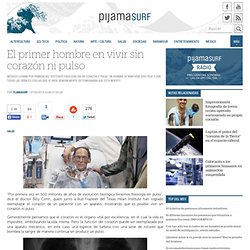
Generalmente pensamos que el corazón es el órgano vital por excelencia, sin el cual la vida es imposible, simbolizando la vida misma. Pero la función del corazón puede ser reemplazada por una aparato mecánico, en este caso una especie de turbina con una serie de rotores que bombea la sangre de manera continua sin producir un pulso. Los médicos probaron esta tecnología de punta de lanza en vaquillas, logrando que estas vivieran de manera natural, comieran y defecaran sin tener un corazón. Parasitología latinoamericana - Experiencia de terapia larval en pacientes con úlceras crónicas. Parasitol Latinoam 61: 160 - 164, 2006 FLAP.

Faster, more sensitive photodetector created by tricking graphene. Researchers at the Center for Nanophysics and Advanced Materials of the University of Maryland have developed a new type of hot electron bolometer a sensitive detector of infrared light, that can be used in a huge range of applications from detection of chemical and biochemical weapons from a distance and use in security imaging technologies such as airport body scanners, to chemical analysis in the laboratory and studying the structure of the universe through improved telescopes.

The UMD researchers, led by Research Associate Jun Yan and Professors Michael Fuhrer and Dennis Drew, developed the bolometer using bilayer graphene--two atomic-thickness sheets of carbon. Due to graphene s unique properties, the bolometer is expected to be sensitive to a very broad range of light energies, ranging from terahertz frequencies or submillimeter waves through the infrared to visible light.
The Maryland team s findings are published in the June 3 issue of Nature Nanotechnology. Newly isolated 'beige fat' cells could help fight obesity. Scientists at Dana-Farber Cancer Institute have isolated a new type of energy-burning fat cell in adult humans which they say may have therapeutic potential for treating obesity.

Called "beige fat," the cells are found in scattered pea-sized deposits beneath the skin near the collarbone and along the spine in adult humans. Because this type of fat can burn off calories -- rather than store them, as "white fat" cells do -- beige fat cells might spawn new therapies for obesity and diabetes, according to researchers led by Bruce Spiegelman, PhD, of Dana-Farber. Spiegelman is the senior author of a report scheduled for advance online publication on July 12 by the journal Cell.
Estado hiperosmolar hiperglucémico. Rev. méd. Chile - Números disponibles. Bacteria-immune system 'fight' can lead to chronic diseases, study suggests. Results from a study conducted at Georgia State University suggest that a "fight" between bacteria normally living in the intestines and the immune system, kicked off by another type of bacteria, may be linked to two types of chronic disease.
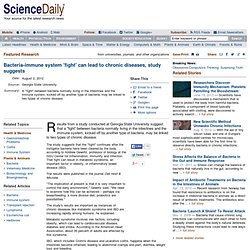
The study suggests that the "fight" continues after the instigator bacteria have been cleared by the body, according to Andrew Gewirtz, professor of biology at the GSU Center for Inflammation, Immunity and Infection. That fight can result in metabolic syndrome, an important factor in obesity, or inflammatory bowel disease (IBD). The results were published in the journal Cell Host & Microbe. "The implication at present is that it is very important to control the early environment," Gewirtz said. "We need to examine how this can be achieved -- perhaps via breastfeeding, a more diverse diet, probiotics are possibilities. " Metabolic syndrome involves risk factors, including obesity, which can lead to cardiovascular disease, diabetes and stroke.
Forma de caminar determinaría si una persona padecerá demencia en el futuro. ¿Sabías que la velocidad a la que caminas diariamente podría determinar si padecerás demencia? Así lo señaló un estudio del Centro Médico de Boston (EEUU), el cual postula que las personas que se desplazan con mayor lentitud tienen más probabilidades de tener dicha enfermedad en un futuro. La investigación, cuyo informe se presentará en el encuentro de la Academia Americana de Neurología en abril próximo, estudió a más de 2 mil 400 hombres y mujeres que rondaban los 60 años de edad. Específicamente, a través de escáneres cerebrales se midió la velocidad a la que caminaban, la fuerza de agarre de sus manos y su función cognitiva.
Durante los 11 años siguientes, los investigadores estudiaron la evolución de los participantes del estudio, comprobando que las personas que inicialmente se desplazaban con mayor lentitud tenían 1,5 veces más posibilidades de desarrollar demencia. Naked mole-rats may hold clues to pain relief. Naked mole-rats evolved to thrive in an acidic environment that other mammals, including humans, would find intolerable.
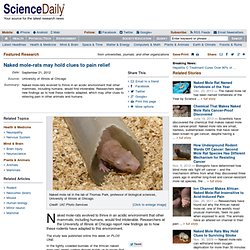
Researchers at the University of Illinois at Chicago report new findings as to how these rodents have adapted to this environment. The study was published online this week on PLOS ONE. In the tightly crowded burrows of the African naked mole-rats' world, carbon dioxide builds up to levels that would be toxic for other mammals, and the air becomes highly acidic. These animals freely tolerate these unpleasant conditions, says Thomas Park, professor of biological sciences at UIC and principal investigator of the study -- which may offer clues to relieving pain in other animals and humans.
Latin American Social Medicine (LASM) : UNM HSC HSLIC. Advanced Search Page. Essential medicines. Acta bioethica - La política focalizada en el programa de vacunación contra el Virus del Papiloma Humano en México: aspectos éticos. WHO Model Lists of Essential Medicines. Herbs at a Glance [NCCAM Health Information] Infomed, Portal de Salud de Cuba. Lista de revistas por materia. Home Page. Alejandro Goic y su actual visión de la Medicina: “Está deshumanizada” La última encuesta del Centro de Estudios Públicos (CEP) abordó un tema que preocupa a la Academia Chilena de Medicina: ante la consulta de si los doctores se preocupan más de sus sueldos que de sus pacientes, el 50% respondió que está de acuerdo.

Por primera vez, el sondeo abordó la percepción que tiene la ciudadana acerca de los médicos y su trabajo. Maggot therapy. A wound cleaned by maggots Maggot therapy is also known as maggot debridement therapy (MDT), larval therapy, larva therapy, larvae therapy, biodebridement or biosurgery.
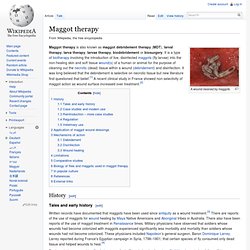
It is a type of biotherapy involving the introduction of live, disinfected maggots (fly larvae) into the non-healing skin and soft tissue wound(s) of a human or animal for the purpose of cleaning out the necrotic (dead) tissue within a wound (debridement) and disinfection. New 'biopsy in a blood test' to detect cancer. Scientists from The Scripps Research Institute, Scripps Health, and collaborating cancer physicians have successfully demonstrated the effectiveness of an advanced blood test for detecting and analyzing circulating tumor cells (CTCs) -- breakaway cells from patients' solid tumors -- from cancer patients.
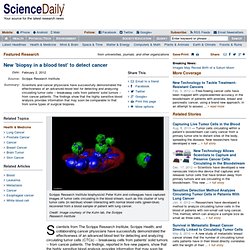
The findings, reported in five new papers, show that the highly sensitive blood analysis provides information that may soon be comparable to that from some types of surgical biopsies. "It's a next-generation technology," said Scripps Research Associate Professor Peter Kuhn, PhD, senior investigator of the new studies and primary inventor of the high-definition blood test. "It significantly boosts our ability to monitor, predict, and understand cancer progression, including metastasis, which is the major cause of death for cancer patients. " The studies were published February 3, 2012, in the journal Physical Biology. New procedure repairs severed nerves in minutes, restoring limb use in days or weeks.
American scientists believe a new procedure to repair severed nerves could result in patients recovering in days or weeks, rather than months or years.

The team used a cellular mechanism similar to that used by many invertebrates to repair damage to nerve axons. 'Pulverized' chromosomes linked to cancer? They are the Robinson Crusoes of the intracellular world -- lone chromosomes, whole and hardy, stranded outside the nucleus where their fellow chromosomes reside. Such castaways, each confined to its own "micronucleus," are often found in cancer cells, but scientists haven't known what role, if any, they play in the cancer process.
In a paper published online on Jan. 18 by the journal Nature, Dana-Farber Cancer Institute researchers have mapped out a mechanism by which micronuclei could potentially disrupt the chromosomes within them and produce cancer-causing gene mutations. The findings may point to a vulnerability in cancer cells that could be attacked by new therapies. "The most common genetic change in cancer is the presence of an incorrect number of intact chromosomes within cancer cells -- a condition known as aneuploidy," says Dana-Farber's David Pellman, MD, the study's senior author. New findings lead to test and therapy for kidney failure caused by E. coli.
Ever since the water supply in Walkerton, Ont., was contaminated by E. coli in 2000, Dr. Philip Marsden has been trying to figure out just how a toxin released by that particular strain of the bacteria causes kidney damage in children. Now Dr. One molecule for muscle growth and insulin sensitivity. Two independent studies in the Nov. 11 issue of the journal Cell, a Cell Press publication, suggest a common way to pump up muscles and prevent diabetes. The key is a molecule required for fine-tuning metabolism by selectively and subtly modifying core metabolic programs.
Researchers show that loss of this molecule specifically in muscle produces mice with more fat-burning muscle and greater exercise capacity. "We turned mice into super-marathon mice," said Johan Auwerx of École Polytechnique Fédérale de Lausanne. "They had more stamina and more endurance. " Another group of researchers show that loss of the same molecule specifically in fat cells produces mice that become more insulin sensitive even as they grow fatter.
The Future of Family Medicine: A Collaborative Project of the Family Medicine Community. Placebos and distraction: New study shows how to boost the power of pain relief, without drugs. Placebos reduce pain by creating an expectation of relief. Distraction -- say, doing a puzzle -- relieves it by keeping the brain busy. But do they use the same brain processes? Neuromaging suggests they do. When applying a placebo, scientists see activity in the dorsolateral prefrontal cortex. That's the part of the brain that controls high-level cognitive functions like working memory and attention -- which is what you use to do that distracting puzzle. Now a new study challenges the theory that the placebo effect is a high-level cognitive function. In the study, 33 participants came in for three separate sessions. Cochrane Evidence Aid: resources for earthquakes - Special Collection. The Cochrane Reviews in this Evidence Aid Special Collection are freely available; please click on the links below to access the reviews.
A selection of Cochrane Reviews and their conclusions for healthcare topics that have been identified as important in the aftermath of a major earthquake. These are signposts to systematic reviews that might be helpful to decision-makers. Topics covered: diarrhoea prevention and treatment; wound management; fracture management; physical trauma (excluding fractures); anaesthesia; renal; chest infections; neonatal health; child health and nutrition and human resources for health.